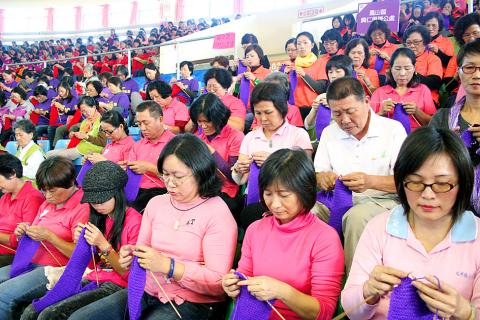More than 1,800 people in Greater Kaohsiung broke a world record yesterday by knitting scarves simultaneously to top off a cultural festival.
A total of 1,805 knitters — including students and community volunteers — completed nearly finished scarves at Fongshan Stadium to mark the end of the Cao Jin Cultural Festival.
They broke the Guinness World Record for the “Largest Number of People Knitting Simultaneously” in a single location that was set by 1,146 knitters at Ireland’s Roscommon Lamb Festival on April 30.

Photo: CNA
The record-breaking knit-a-thon was witnessed by Tsai Po-ying (蔡柏英), deputy director-general of Greater Kaohsiung’s Civil Affairs Bureau and a lawyer.
The organizers said they would register the feat with the Guinness World Records.
The scarves will be given away to underpriviledged groups, including the disabled, senior citizens living in nursing homes and single-parent families, the organizers said.
The annual festival is held in memory of Cao Jin (曹謹), a municipal director during the Qing Dynasty, for his efforts to build the Caogong Canal, which consisted of 44 water channels that helped irrigate 2,473 hectares of agricultural land.

The Ministry of Education (MOE) is to launch a new program to encourage international students to stay in Taiwan and explore job opportunities here after graduation, Deputy Minister of Education Yeh Ping-cheng (葉丙成) said on Friday. The government would provide full scholarships for international students to further their studies for two years in Taiwan, so those who want to pursue a master’s degree can consider applying for the program, he said. The fields included are science, technology, engineering, mathematics, semiconductors and finance, Yeh added. The program, called “Intense 2+2,” would also assist international students who completed the two years of further studies in

Former president Tsai Ing-wen (蔡英文) departed for Europe on Friday night, with planned stops in Lithuania and Denmark. Tsai arrived at Taiwan Taoyuan International Airport on Friday night, but did not speak to reporters before departing. Tsai wrote on social media later that the purpose of the trip was to reaffirm the commitment of Taiwanese to working with democratic allies to promote regional security and stability, upholding freedom and democracy, and defending their homeland. She also expressed hope that through joint efforts, Taiwan and Europe would continue to be partners building up economic resilience on the global stage. The former president was to first

Taiwan will now have four additional national holidays after the Legislative Yuan passed an amendment today, which also made Labor Day a national holiday for all sectors. The Chinese Nationalist Party (KMT) and Taiwan People’s Party (TPP) used their majority in the Legislative Yuan to pass the amendment to the Act on Implementing Memorial Days and State Holidays (紀念日及節日實施辦法), which the parties jointly proposed, in its third and final reading today. The legislature passed the bill to amend the act, which is currently enforced administratively, raising it to the legal level. The new legislation recognizes Confucius’ birthday on Sept. 28, the

The Taipei District Court sentenced babysitters Liu Tsai-hsuan (劉彩萱) and Liu Jou-lin (劉若琳) to life and 18 years in prison respectively today for causing the death of a one-year-old boy in December 2023. The Taipei District Prosecutors’ Office said that Liu Tsai-hsuan was entrusted with the care of a one-year-old boy, nicknamed Kai Kai (剴剴), in August 2023 by the Child Welfare League Foundation. From Sept. 1 to Dec. 23 that year, she and her sister Liu Jou-lin allegedly committed acts of abuse against the boy, who was rushed to the hospital with severe injuries on Dec. 24, 2023, but did not